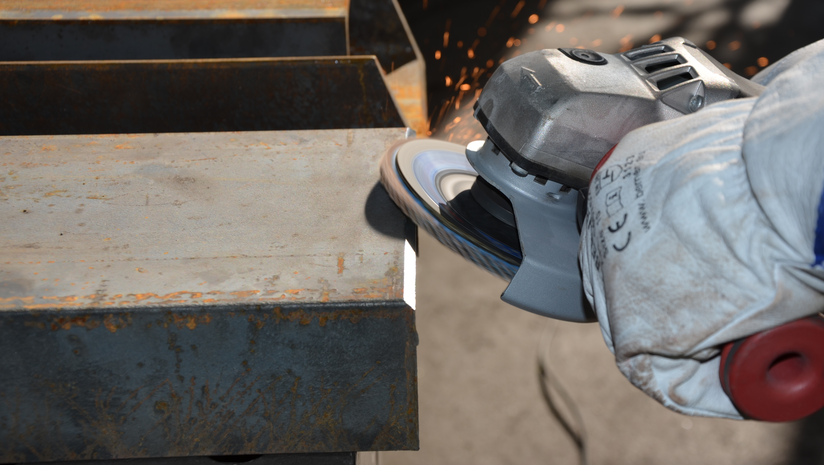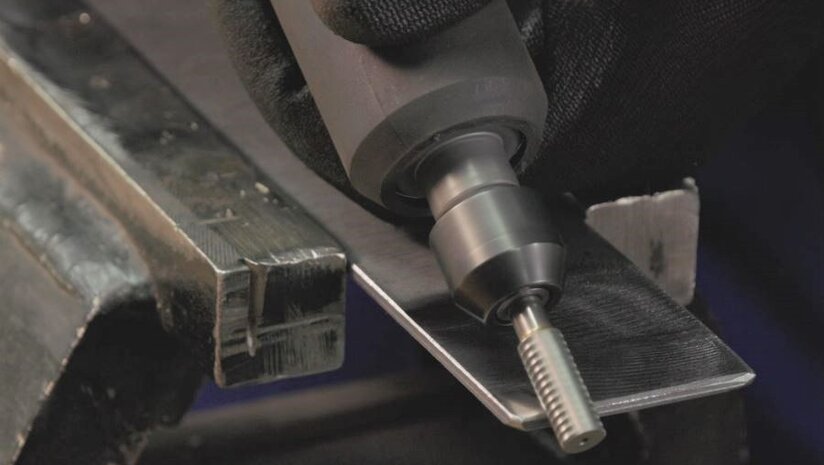
Beveling
If two workpieces are to be welded together, the edge of the workpieces must first be broken by a beveled surface. This is done by machining. The result is a chamfer, also known as a bevel.
What is beveling and
why is it important?
If two workpieces are to be welded together, the edge of the workpieces must first be broken by a beveled surface. This is done by machining. Or in other words, a space is created to accommodate the individual welding layers through which the workpieces are joined together. The bevel can have different shapes. The V-joint, the double V-joint, and the Y-joint are the most common shapes.
Which tool is used for beveling?
The position of the weld, the material of the workpiece, and the types of drives available - the choice of the right tool depends on various factors.
If an angle grinder is available, the beveling can be done with sulfur- and iron-free Osborn flap discs. Flap discs with a conical or straight shape are available. The angle on the workpiece determines the shape of the flap wheel.
If a workpiece made of non-ferrous metal is to be beveled, we recommend an abrasive cloth with a cooling bond as it reduces blue tarnish.

Pictured: Beveling with an Osborn flap disc.
If a straight grinder or air grinder is available, chamfering can be done with carbide burrs. The milling head is made of tungsten carbide-cobalt, the shank of tool steel. Different head shapes and toothings ensure that there is the right solution for every application.
For chamfering, burrs with cross serration (Z6) are the best choice. It ensures high stock removal in a short time. If the surface quality is important, a single tooth (Z3) is recommended. In the shipyard sector, the special shipyard toothing is often used. Compared to the Z6 toothing, it has a 30% higher material removal rate.

Camfering with a carbide burr.
Products for
Beveling.

Deck Scrub Brush
Heavy duty Osborn deck brush with hardwood block and built-in squeegee.

Pointed End Scrub Brush
Solid hardwood block designed with grooved, shaped sides and white Tampico fill for targeted wet or dry surface scrubbing.

Radiator Brush
Designed with natural Pure China Bristle and angled hardwood handle for use in confined, hard-to-reach areas.

FLR Flanged - Concentric Stud Style, Inch Sizes
Flanged Concentric Stud Style Cam followers are a type of cam follower bearings that have a flange on one side and a stud on the other side. The stud provides a way to attach the bearing to a shaft or other mechanism, while the flange helps to locate and stabilize the bearing. These cam followers are typically used in applications where a high load capacity is needed, and where the bearing needs to be attached to a shaft or other mechanism.

FLRE - Flanged Eccentric Stud Style - Inch Sizes
Flanged eccentric stud style cam followers are bearings that consist of a cylindrical outer ring with a flange on one end and an inner ring that is attached to the stud shaft by an eccentric collar. This design allows for adjustability of the radial clearance between the cam and the follower. The flange on the outer ring allows for easy installation and the stud shaft can be used for attaching other machine components.

FLRC - Flanged Crown Style - Concentric Stud Style, Inch Sizes
Flanged crown concentric cam followers are a type of bearing that consist of a cylindrical outer ring with a flange on one end, and a cylindrical or crowned inner ring that rotates around a central axis. They are designed to follow the movement of a cam, which is a mechanical device that converts rotary motion into linear motion. The flange on the outer ring allows for easy installation, while the concentric design helps to maintain proper alignment and reduce wear on the bearing.

FLRY Flanged Yoke Style - Inch Sizes
A Flanged Yoke Style Cam Follower is a type of roller bearing that has an outer flange or rim to increase the surface area and stability of the bearing. It is commonly used in high-load and high-misalignment applications, providing increased stability and accuracy for the cam or track it is following. The flange also helps to simplify the mounting process and provides additional support for the bearing.

FLRCE
Flanged crowned eccentric stud cam followers are a type of bearing that consist of a cylindrical outer ring with a flange on one end, and an inner ring that rotates around a central axis which is offset from the bearing center. They are designed to follow the movement of a cam, which is a mechanical device that converts rotary motion into linear motion. The flange on the outer ring allows for easy installation and the eccentric design allows for adjustability in the radial direction.

FLRS Stainless Steel Concentric Stud Flanged Cam Followers - Inch Sizes
Stainless steel concentric stud flanged style cam followers are bearings that consist of a cylindrical outer ring with a flange on one end, a central concentric stud that allows for attaching other machine components and a inner ring that rotates around the stud axis. They are made of stainless steel which is highly resistant to corrosion and rust. This makes them suitable for use in harsh environments where corrosion resistance is required.

ATB Situft™ Internal Brush
Osborn’s ATB Situft™ Internal Brushes feature premium-quality abrasive nylon filaments to provide efficient, aggressive abrasive action across a wide range of internal cleaning and finishing operations. Situft™ brushes should be used only with suitable holders.

ATB Helituf™ Internal Brush
Osborn ATB Helituf™ Internal Brushes are designed with high-quality nylon filament embedded with durable Silicon Carbide and unique helix design to provide efficient internal surface cleaning and deburring action. Helituf™ brushes should only be used with suitable holders and fully chucked.

ATB™ Rectangular Filament Internal Brush
Featuring rectangular nylon strips impregnated with tough Aluminum Oxide, Osborn’s ATB™ Rectangular Filament Internal Brush provides a highly efficient side-sweeping action across the surface. Filament shape applies approximately 18 times more abrasive contact than traditional round filaments. Aluminum Oxide ensures a superior finish and prolonged brush life.